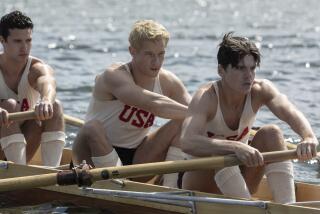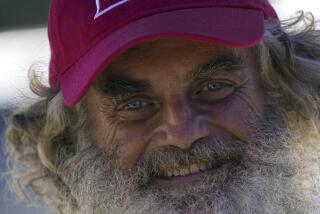Plight of Epileptic Rower Grows Increasingly Dire
- Share via
This truly is the age of adventure. Throw a dart at a map and there’s probably an expedition taking place where it sticks.
There are surfers in Antarctica, dropping in alongside icebergs, probably unaware there are skiers and snowboarders just around the bend, sliding down glaciers.
There’s a Massachusetts sailor somewhere off Chile, trying to circumnavigate the world in a boat made of reeds by Bolivian Aymara Indians on the shores of Lake Titicaca.
Soon, there will be a famous mountaineer, Ed Viesturs, setting out to conquer his final two peaks--Nanga Parbat in Pakistan and Annapurna in Nepal--in an attempt to become the first American to stand atop all 14 of the world’s 8,000-meter summits.
And then there is Andrew Halsey, probably the loneliest soul on the planet, bobbing around in the middle of the Pacific Ocean, not making much headway, with no means of communication and no chance of making landfall before running out of provisions.
Until now, nobody has paid much attention to Halsey, an intrepid adventurer in serious jeopardy of fading into his final sunset.
Halsey, 41, an Englishman with epilepsy, is trying to row his 27-foot boat across the Pacific, more than 6,000 miles in a straight line from San Diego to Sydney, Australia.
Most expeditions of this magnitude receive widespread media attention and a Web site dedicated to the effort, thanks to corporate sponsorship and PR work that comes with it. Not Halsey’s. Nobody wanted any part of him, but he went ahead anyway, with only the barest of necessities.
“Most of these rowers who get these huge sponsorships spend the last night before their departure in a fine hotel and are wined and dined lavishly before setting off,” says Kenneth Crutchlow, director of the London-based Ocean Rowing Society, which provides at least some support for those so passionate about paddling. “But Andrew, because he had no such support, was forced to stay at some flea-bag motel in San Diego and probably ate at McDonald’s before he left.”
Two others have rowed alone across the Pacific: England’s Peter Bird, from San Francisco to Australia in 294 days, and France’s Gerard d’Aboville, from Japan to Washington in 134 days. A few dozen have traversed the Atlantic Ocean.
Bird was lost at sea and presumed dead during another trans-Pacific crossing; Halsey is dangerously close to following Bird on both counts.
Halsey left San Diego on July 15 and has been struggling against Mother Nature since. Shifting seas have capsized his self-righting vessel often, at one point causing him to break a tooth and his knee to give out. Fortunately, he’s constantly attached with a harness, as a means of protection from both capsizing and seizures.
Strong winds he had hoped would be at his back at least part of the journey have been against him almost from the outset. Even the currents have not cooperated for a man who seemingly has been rowing in circles.
Veteran ocean rowers usually average about 1,000 miles per month, sleeping sparingly in small cabins that protect them from the weather.
Halsey already has rowed an estimated 6,000 miles, but he remains less than 2,000 miles offshore and 5,000 miles shy of his objective. And concerns are growing among a small group of supporters in England that he may not come out of this great adventure alive.
His e-mail system broke down in late October, leaving him with no means of communication. His food supply is expected to run out by April 15, and he has no chance of reaching land by then. He is equipped with a tracking beacon--his position indicates his luck has not changed since he lost his e-mail ability--and can send an emergency distress signal, but the power sources that drive those devices also are running low.
The U.S. Coast Guard will not initiate a rescue effort unless Halsey requests one via distress signal, and Halsey’s supporters fear that the rower is too determined and too stubborn--or both--to do so.
“Meanwhile, we have every indication that he is basically just plodding on,” Crutchlow says. “We might mount a rescue effort of our own, at least to resupply him before April 15, but we don’t know how or on what boat, or who’s going to pay for all this.”
Crutchlow held a news conference in London on Wednesday to spread word of Halsey’s plight, and the Evening Standard ran a story the same night under the headline: “He vowed to row the Pacific if it killed him--now it might.”
Halsey, who started out with provisions for 250 days, a desalinating device to make drinking water, a single-burner gas stove and a bottle of gin, is no stranger to adversity. He has been swimming in a sea of it most of his life.
At 25, he was a steward on a ship that sailed from England to Gulfport, Miss., where it was promptly confiscated because of unpaid bills. Halsey had expected to be paid for his work on the ship. Instead he was deported.
He eventually returned to Mississippi to marry a woman he had met there. He didn’t know he had epilepsy then. He found out after suffering his first seizure one Christmas Day, landing on his face, breaking his nose and waking up in a hospital bed not knowing what had happened.
Though the couple had a child, a daughter named Brittany, the marriage was rocky and didn’t last. A bricklayer by trade, Halsey had trouble finding work. They moved to England for a fresh start. But one day, while he was at work, his wife took their infant daughter and flew home to live with her parents in Iowa. She sent him divorce papers in the mail a year later and only then did he learn their whereabouts.
It took years for Halsey to save enough money to fly to Iowa and when he got there and saw Brittany again, she was 6.
He was unable to reconcile his differences with his wife, however, and returned to England.
Long fascinated with the sea, he eventually decided to row across an ocean, following in the wake of other English rowers, notably Bird. He met Crutchlow, who put him in touch with a boat builder, and the two produced the 27-foot rowing vessel Halsey named after his daughter, Brittany Rose.
Money again was a problem and big companies were uncooperative. Halsey’s endeavor seemed dead in the water before it began. But then he experienced a rare stroke of good fortune: He fell off a ladder during a construction job, breaking his ankle. He eventually received a $30,000 insurance settlement.
That was all it took. Halsey outfitted his vessel and had it shipped to the Canary Islands off northern Africa, and set a course for St. Lucia in the Caribbean before his creditors could catch up with him.
The winds were against him from the start. Huge swells swamped his vessel, shorting his short-wave radio and damaging his food supply. Seasickness prevailed. Depression set in.
One passage in his log book reads like the next: “Gale force winds. Won’t be doing any rowing today. Or cooking. Or fishing. Feels like I’m going around in circles.”
Halsey eventually made it to St. Lucia, after being at sea 119 days. He weighed 175 pounds when he shoved off. He stepped off his boat weighing 133 pounds.
Now he’s at it again, for reasons only he really knows.
Crutchlow says Halsey wants to make a statement that people with epilepsy are not as disabled as some might think. He also believes he’s doing this in an attempt to get the attention of his daughter, now 15.
“He doesn’t even know where she is,” Crutchlow says. “He has tried finding her, even using the Internet, but to no avail. He’s hoping that if she somehow reads about his journey or sees a picture of his boat, which carries her name, she might someday try to find him.
“Regardless of what kind of statement Andrew is trying to make, this is an extraordinary effort on his part.”
*
Kenneth Crutchlow can be reached on the Internet at https://www.oceanrowing.com.
More to Read
Sign up for The Wild
We’ll help you find the best places to hike, bike and run, as well as the perfect silent spots for meditation and yoga.
You may occasionally receive promotional content from the Los Angeles Times.






